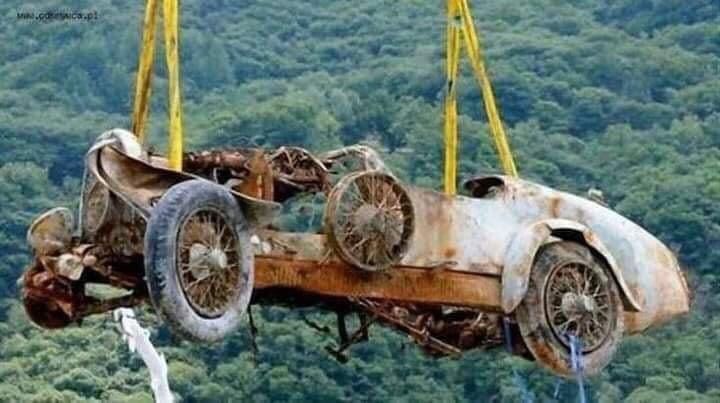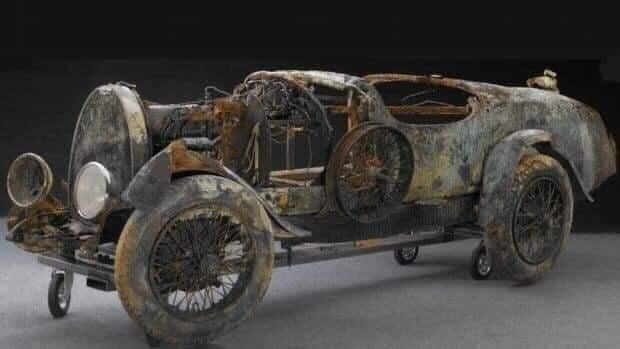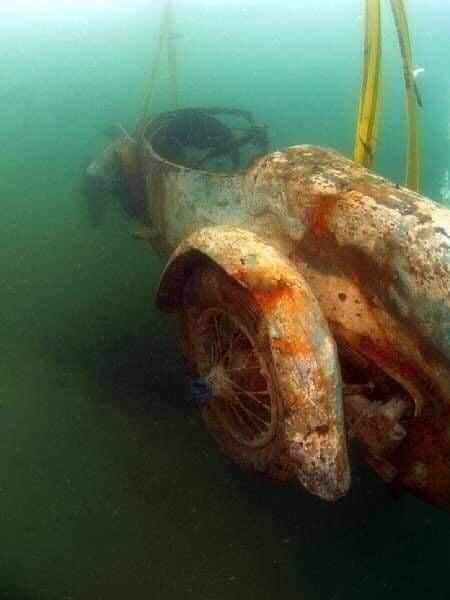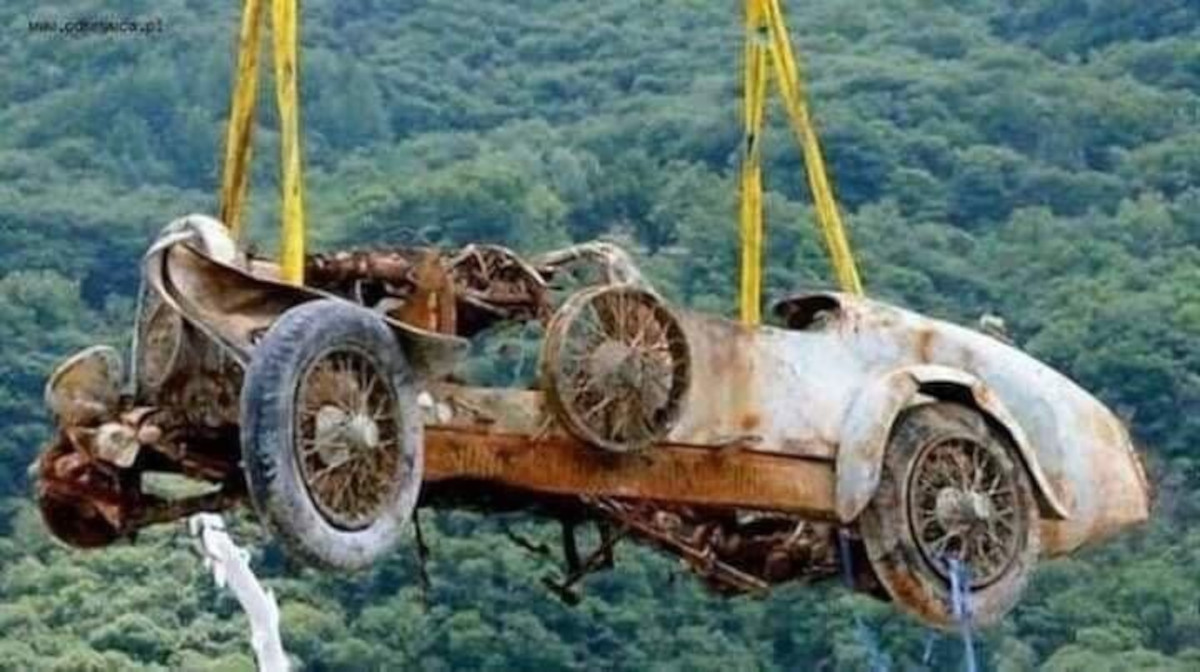- The 1925 Bugatti Type 22 Brescia Roadster is an iconic car designed by Ettore Bugatti, known for its lightweight design and racing pedigree.
- The car was lost in a poker game in 1934 by renowned French Grand Prix driver René Dreyfu to Swiss playboy Adalbert Bodé.
- In 1935, after being transported to Switzerland, the car was abandoned and submerged in Lake Maggiore due to unpaid customs duties.
- The Bugatti remained underwater for 73 years before being recovered in 2009, becoming an international sensation.
- Despite heavy corrosion, the car’s frame remained intact, with many original components still recognizable.
The automotive world is rich with stories of speed, design, and innovation. Few cars can match the mystique and allure of the 1925 Bugatti Type 22 Brescia Roadster.
Pulled from Lake Maggiore in 2009 after spending 73 years underwater, the Bugatti’s journey from a Grand Prix-winning roadster to a submerged relic captures the imagination of car enthusiasts, historians, and collectors alike.
A Brief History of the Bugatti Type 22 Brescia Roadster
The Bugatti Type 22 Brescia is one of the most iconic cars from the 1920s. Designed by Ettore Bugatti, this lightweight sports car featured a four-cylinder 1.5-liter engine and was a favorite among racing enthusiasts for its nimbleness and speed.
The Type 22 evolved from the Type 13, a car dominating motorsports at the time. Bugatti’s engineering vision centered on agility rather than sheer power.
The Type 22, weighing just over 1,600 pounds, could reach speeds close to 100 miles per hour—a remarkable feat in the 1920s. The Brescia was named after the Italian town where Bugatti claimed a famous racing victory in 1921, underscoring the car’s sporting pedigree.

The Notorious Poker Game: From Dreyfus to Bodé
One of the most intriguing chapters of the Bugatti Type 22 Brescia Roadster’s story involves a legendary poker game. In 1934, renowned French Grand Prix driver René Dreyfus, known for his competitive spirit and numerous racing victories, allegedly lost the car in a drunken poker game.
His opponent? Swiss playboy Adalbert Bodé, a man more interested in high-stakes gambling than automobiles.
While this exchange sounds like something out of a novel, rumors about the transaction circulated for decades. Whether Dreyfus and Bodé’s fateful card game actually occurred, the Bugatti indeed found its way into Bodé’s hands, and from there, its journey took an unexpected and dramatic turn.
The Mystery of Lake Maggiore: The Car’s Submersion
In 1935, the Bugatti Type 22 Brescia Roadster was transported to Switzerland. However, the transfer did not go smoothly. Swiss customs officials imposed a hefty import tax on the car, one Bodé was unwilling—or unable—to pay.
Facing an expensive bureaucratic roadblock, Bodé made a choice which would ultimately define the Bugatti’s legacy: he abandoned the car.
But instead of leaving it to collect dust in a garage, legend has it Bodé chose to dispose of the car by dumping it into Lake Maggiore, a picturesque alpine lake straddling the border between Switzerland and Italy.
For the next 73 years, the Bugatti sat undisturbed at the bottom of the lake, gradually becoming part of the lake’s ecosystem.
Discovery and Recovery: Bringing the Bugatti to the Surface
It wasn’t until 2009 the Bugatti Type 22 Brescia Roadster was pulled from Lake Maggiore, sparking a global media sensation. The discovery was part of a larger recovery effort led by a team of underwater specialists and car enthusiasts who knew the vehicle’s rumored location.
By the time the Bugatti was hoisted to the surface, it had been submerged for nearly three-quarters of a century. The car was corroded, its metal frame largely intact but covered in rust and barnacles. Despite this, many of the original components remained, a testament to Bugatti engineering.
Why Was the Bugatti Left Unrestored?
After its recovery, the decision to leave the Bugatti unrestored surprised many. Restoring a classic car to its former glory is often seen as an essential part of preserving automotive history.
However, in the case of the Bugatti Type 22 Brescia Roadster, the decision to keep it in its current, rusted state speaks volumes about its significance.
By leaving the car unrestored, the Mullin Automotive Museum allowed the Bugatti to retain its unique identity as both a symbol of early 20th-century engineering and a relic of the lake which preserved it.
The contrast between the car’s once-glorious past and its current state of decay makes it a compelling artifact, inviting viewers to reflect on the intersection of history, technology, and time.

The Engineering Behind the Bugatti Type 22
Bugatti cars are renowned for their performance and innovation, and the Type 22 Brescia Roadster is no exception. Powered by a four-cylinder 1.5-liter engine, this model produced about 50 horsepower—a respectable figure for its time.
Bugatti’s engineering philosophy during the 1920s focused on creating lightweight cars with superior handling. The Type 22’s frame was built from a mix of steel and aluminum, and it employed a three-speed manual transmission.
Although modest in power compared to later Bugatti models, its low weight allowed the car to achieve remarkable agility and speed.
The Type 22’s most notable design feature was its braking system, which employed four-wheel drum brakes—an advanced technology for its time. This allowed the car to stop efficiently compared to many of its contemporaries, making it fast and safe for racing conditions.
The car’s suspension system, featuring semi-elliptic leaf springs, provided smooth handling over rough terrain, ensuring its prowess in hill climbs and other early motorsport events.
Bugatti’s Racing Heritage: The Brescia Connection
The Type 22 Brescia Roadster holds a special place in Bugatti’s racing heritage. The “Brescia” moniker was given in honor of Bugatti’s 1921 victory at the Brescia Grand Prix, a significant motorsport event in Italy. This victory marked a turning point for Bugatti, establishing the brand as a dominant force in racing.
The Type 22, along with its predecessor the Type 13, was instrumental in Bugatti’s success during the 1920s. These cars were compact, nimble, and powerful for their size—qualities which made them perfect for the tight turns and hilly landscapes of European racecourses.
The Brescia win solidified Bugatti’s reputation, and the Type 22 became a sought-after model for both professional racers and wealthy enthusiasts.
The Cultural and Historical Impact of the Bugatti Type 22
The cultural significance of the Bugatti Type 22 Brescia Roadster extends far beyond its engineering and racing pedigree. In the 1920s and 1930s, owning a Bugatti was a symbol of prestige. Ettore Bugatti’s vehicles were favored by aristocrats, playboys, and racing drivers alike. The fact this particular car found itself in the hands of René Dreyfus, one of the era’s most celebrated drivers, further enhances its mythos.
The car’s submersion in Lake Maggiore and its subsequent discovery elevated it to legendary status. It’s no longer just a relic of automotive history; it’s a symbol of chance, loss, and history preserved in metal. The Bugatti Type 22 Brescia Roadster remains a reminder even the most advanced and celebrated machines can become forgotten, only to be rediscovered as historical treasures.
Why the Mullin Museum Chose to Exhibit the Unrestored Bugatti
When the Bugatti was recovered, it presented a unique opportunity for museums and collectors. However, the decision to exhibit the car in its unrestored form at the Mullin Automotive Museum had a profound impact on how the vehicle is perceived.
Instead of restoring the car to its former glory, the museum chose to preserve it as a “time capsule.” This decision allowed visitors to appreciate the car’s storied past, while also engaging with it as an artifact of nature’s transformative power.
The corroded body, covered in rust and marine growth, tells a story of technological achievement and the forces of decay.
By exhibiting the Bugatti in this condition, the Mullin Museum highlights broader themes of preservation, history, and impermanence of even the most advanced creations. The car’s display draws attention to its unique journey—from a luxurious racing machine to an abandoned relic submerged in a lake, to a museum centerpiece inviting contemplation.
The Value of the Bugatti Type 22 Brescia Today
The Bugatti Type 22 Brescia Roadster is valued for its rarity and the incredible story accompanying it. While fully restored Bugatti models from the same era can fetch millions of dollars at auctions, this unrestored example is priceless in its own way.
It stands as a historical artifact, a piece of automotive folklore, and a reminder of the Bugatti brand’s enduring legacy. Its value lies in its ability to tell a story which goes beyond horsepower, speed, and racing victories. It speaks to the human experience—of loss, rediscovery, and the passage of time.

Conclusion: The Legacy of the Bugatti Type 22 Brescia Roadster
The 1925 Bugatti Type 22 Brescia Roadster is more than just a classic car. Its story is a testament to the unpredictability of life and the enduring power of human curiosity.
From a high-stakes poker game to the bottom of Lake Maggiore, and finally to the Mullin Automotive Museum, this Bugatti’s journey captures the imagination like few other vehicles.
In its unrestored state, the Bugatti invites reflection on the fragility of man-made machines and the moments they represent.
As it continues to inspire automotive enthusiasts and historians, the Type 22 Brescia Roadster remains a symbol of the ever-evolving relationship between art, technology, and time.
Key Takeaways
- The 1925 Bugatti Type 22 Brescia Roadster is a historically significant car known for its lightweight design and impressive racing capabilities.
- The car was lost in a poker game by Grand Prix driver René Dreyfus and eventually abandoned in Lake Maggiore for 73 years.
- Recovered in 2009, the Bugatti’s corroded but intact condition has captured global interest.
- The Mullin Automotive Museum chose to leave the car unrestored, preserving its unique story and the effects of time.
- The car’s value lies in its engineering excellence, cultural impact, and captivating legend, making it an irreplaceable artifact in automotive history.
- The Bugatti Type 22 Brescia is a symbol of preservation, representing the intersection of technology, history, and nature’s transformative power.


































